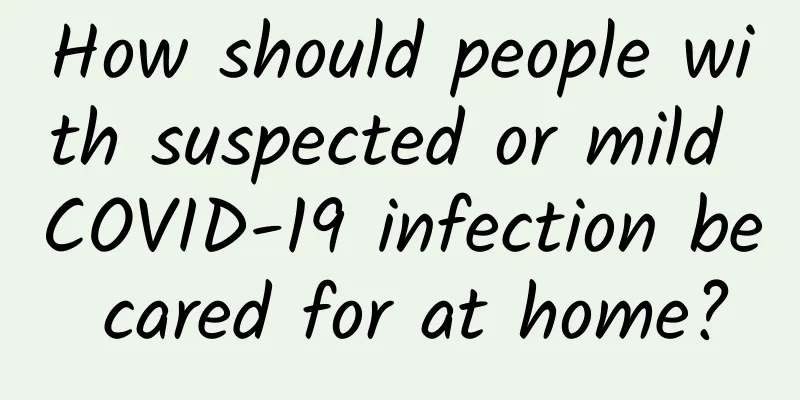How should people with suspected or mild COVID-19 infection be cared for at home?

|
Following Xi'an and Shenzhen, the epidemic in Shanghai has attracted national attention, and many cities have also strengthened epidemic prevention and control. As the number of new coronavirus infections continues to rise, some people cannot get retested or enter isolation areas immediately after testing positive for antigen or nucleic acid, and have to temporarily receive home care. At this time, how should the infected take care of themselves? What should their family members do? In January last year, we briefly translated the World Health Organization's recommendations for home care for suspected novel coronavirus infections, and introduced the correct way to sneeze and wash hands. It is reprinted today for everyone to review and study. Written by | Cai Cai On January 20, the World Health Organization published a "Home care for patients with suspected novel coronavirus (nCoV) infection presenting with mild symptoms and management of contacts", which is a home care guide for patients with mild symptoms* and suspected infection with the new coronavirus (hereinafter referred to as the new coronavirus). This is a revision of the "Home Care Guidelines for MERS Infected Patients with Mild Symptoms" in June 2018. If the epidemic situation changes, the guidelines will also be revised, so they are not static. *Note: Mild symptoms refer to the presence of low-grade fever, cough, fatigue, runny nose, sore throat, etc., and the absence of the following warning symptoms: shortness of breath or difficulty breathing, increased breathing (sputum or hemoptysis), gastrointestinal symptoms such as nausea/vomiting/diarrhea, and changes in mental state such as confusion/drowsiness. According to the "Diagnosis and Treatment Plan for New Coronavirus Pneumonia (Trial Ninth Edition)" issued by the State Council on March 14 this year, mild symptoms refer to mild clinical symptoms and no signs of pneumonia in imaging studies. **Note: Download address of the old version of MERS Home Care Guide (Chinese version): https://apps.who.int/iris/bitstream/handle/10665/174652/WHO_MERS_IPC_15.1_chi.pdf;jsessionid=07911B7E291F78EA33BFF0CF2235B66F?sequence=11 WHO recommends isolating and monitoring patients suspected of being infected with COVID-19 in hospitals to ensure medical safety, quality of medical care (to prevent patients' symptoms from worsening), and public health safety. However, for various possible reasons, such as the patient being unable to be hospitalized; or the hospital having limited capacity and resources and being unable to meet the demand for medical services; or the patient knowingly refusing hospitalization, alternative medical services other than hospitalization may need to be considered. If the above situation occurs, the patient can receive home care if the symptoms are mild and there are no underlying chronic diseases, such as lung disease, heart disease, kidney failure, immune dysfunction, etc., which may increase the patient's risk of complications. The same principles of home care also apply to symptomatic patients who no longer need hospitalization. Whether to hospitalize or receive home care requires careful clinical judgment and an assessment of the safety of the patient's home environment. During home care, communication with the health care provider should be maintained until the patient has fully recovered. A health care provider should call to review the patient's health status and symptom progression. Ideally, the health care provider should follow up with the patient face-to-face on a regular basis, if feasible, and perform specific diagnostic tests if necessary. In addition, patients and their families should receive training on personal hygiene, basic infection prevention and control measures, and know how to care for family members who may be infected as safely as possible and prevent the spread of the virus to other family members. Patients and their families should receive ongoing support, training, and monitoring. Patients and their families should follow these recommendations: 1. Place the patient in a well-ventilated single room. 2. Limit the number of caregivers assigned to patients, preferably by designating a healthy and risk-free person as a "caregiver" to look after the patient. Patients are not allowed to accept visits from others. 3. Family members should live in other rooms and not in the same room with the patient. If this is not possible, please keep at least 1 meter away from the patient (such as sleeping in separate beds). 4. Patients can only move in a limited space, and the space shared with family members should be minimized. Shared spaces such as kitchens and toilets should be well ventilated (for example, keep windows open for ventilation). 5. When the "caregiver" is in the same room with the patient, he/she needs to wear a medical mask that fits tightly to the face and should not touch or adjust the mask. If the mask is wet or dirty with secretions, it must be replaced immediately. The mask should be discarded after use, and hands should be washed immediately after taking off the mask. 6. Wash your hands after contact with patients and their surroundings. Wash your hands before and after preparing food, before meals, after defecation, and when your hands are dirty. If your hands do not look dirty, you can wash them with alcohol-based hand sanitizer. If your hands look obviously dirty, wash them with soap and water. In addition, before using alcohol-based hand sanitizer, you must fully understand the potential safety hazards it may bring, such as accidental ingestion and flammability. 7. When washing your hands with soap and water, it is best to dry your hands with disposable paper towels and discard the paper towels in time. If disposable paper towels are not available, use a dedicated towel to dry your hands and replace the towel in time if it becomes wet. 8. Everyone in the home (especially patients) should always maintain respiratory hygiene. Respiratory hygiene means covering your mouth and nose with a medical mask, cloth mask, tissue or bent elbow when coughing or sneezing, and then washing your hands in time. 9. Materials used to cover the mouth and nose should either be discarded immediately or washed promptly after use (e.g., a handkerchief with soap/detergent and water). 10. Avoid direct contact with body fluids, especially oral or respiratory secretions, and feces. Please use disposable gloves for oral or respiratory care, and also use disposable gloves to handle feces, urine and related waste. Wash your hands before and after wearing gloves. 11. Prepare a lined container in the patient's room to collect and place gloves, tissues, masks used by the patient and in the process of caring for the patient, as well as other garbage generated in the process, and then discard it with other garbage at home. 12. In addition to gloves, tissues, and masks, avoid other types of items that may be touched by the patient, or may be exposed to the patient's surroundings and may be contaminated (for example, avoid sharing toothbrushes, cigarettes, tableware, dishes, drinks, bath towels, towels, and bed sheets with the patient). Used tableware and dishes should be cleaned with soap/detergent and water and can be reused. 13. Frequently touched surfaces in the home, such as bedside tables, bed frames, and other bedroom furniture, should be cleaned daily and disinfected with a regular household disinfectant containing 1% bleach. 14. Clean toilet and bathroom surfaces daily and disinfect with a regular household disinfectant containing 1% bleach. 15. Wash the patient's clothing, bedding, bath towels, and towels with regular laundry soap and water, or machine wash at 60–90°C with regular detergent and dry thoroughly. Place used bed linens in a special laundry bag. Do not shake dirty clothes or bed linens, and avoid direct contact of skin and clothing with these potentially contaminated fabrics. 16. Use disposable gloves and protective clothing (such as plastic aprons) when cleaning and handling furniture surfaces, objects, clothing, and bed sheets stained with the patient's body fluids. Wash your hands before and after. 17. People who develop symptoms should stay at home until clinical examination and/or laboratory tests show that the symptoms have resolved (the standard for laboratory tests is: two RT-PCR results at least 24 hours apart are both negative). All family members should be considered "contacts" and their health status should be monitored according to the following standards; if any family member has symptoms of acute respiratory infection (including fever, cough, sore throat and difficulty breathing), please refer to the public health advice in the following standards. Healthcare workers involved in or providing home care should undergo a risk assessment to select appropriate personal protective equipment. Management of “contacts” Given the limited evidence of human-to-human transmission of COVID-19, people who may have had contact with suspected COVID-19 patients (including medical staff) are advised to closely monitor their health for 14 days from the last day of contact. If they develop fever, respiratory symptoms (cough, shortness of breath, etc.), and diarrhea, please seek medical attention immediately. During the observation period, the "contact" should keep in touch with the medical staff. A medical staff should call to review the health status and symptom progression of the "contact". Ideally, if feasible, the medical staff can conduct regular face-to-face follow-up with the "contact" and perform specific diagnostic tests when necessary. Medical staff should inform the "contact" in advance where to seek medical treatment after becoming ill, what is the most appropriate mode of transportation, when and where to enter the designated medical institution, and what infection control precautions should be followed. When a "contact" who develops symptoms goes to a medical institution for treatment, the medical institution should be notified in advance. When seeking medical treatment, you should wear a medical mask. Try to avoid taking public transportation to medical institutions; call an ambulance or use a private car to transport "contacts" who show symptoms, and open the windows as much as possible. "Contacts" who develop symptoms are advised to maintain respiratory hygiene and hand hygiene at all times; and when in transport or in medical institutions, they should stand or sit as far away from others as possible (at least 1 meter away). Both “contacts” and caregivers who develop symptoms should wash their hands frequently. During transportation of symptomatic “contacts” to seek medical care, all surfaces soiled by respiratory secretions or body fluids should be cleaned and disinfected with a regular household disinfectant containing 1% bleach. For any operational issues, please handle them with caution under the guidance of professional medical staff. Learn "sneeze etiquette" to protect others' safety Let’s first look at a high-speed photograph of a person sneezing: (Animation from Bourouiba, L., Dehandschoewercker, E. & Bush, JM Violentexpiratory events: on coughing and sneezing. Journal of Fluid Mechanics 745,537-563, doi:10.1017/jfm.2014.88 (2014).) In the lightning-fast 0.34 seconds, the saliva has spread 70 centimeters away, and the trajectory of the spread is also in all directions like fireworks: It is conceivable that the virus or bacteria carried by the person who sneezes (or coughs) will also take advantage of the saliva and float in the wind, spreading, spreading, spreading... Of course, many people already know that they should cover their mouth when they sneeze, but there are also some rules for how to do it: in a word - when you sneeze or cough, you must cover your mouth, but you cannot put your hands together to cover your mouth. (Source: https://susanvanhoosen.com/daily-tips/top-5-tips-to-avoid-getting-sick-this-season) This is because when you sneeze, you cover your mouth with your hand or a tissue, but the droplets penetrate the tissue and stick to your hands. If you do not wash your hands immediately after sneezing, and then open the door or touch other objects, the virus or bacteria may be stained on the doorknob or other objects. Then the next person to open the door or take something may touch a hand full of saliva containing viruses or bacteria... How long can the newly discovered new coronavirus survive on door handles? There is not enough data yet. But we already know that some viruses can survive on door handles and surfaces for quite a long time, such as respiratory syncytial virus, which can survive for 6 hours, parainfluenza virus, which can survive for 10 hours, and norovirus, which can survive for several days or even weeks (data from the NHS website https://www.nhs.uk/common-health-questions/infections/how-long-do-bacteria-and-viruses-live-outside-the- In short, the general principle of sneezing is to try not to spray droplets and not get droplets on your hands. So you should use thicker tissues (or multiple layers). If you don't have a tissue or don't have time to get one, bury your head in your arms and sneeze with your sleeves covering your mouth and nose. This is the best way to avoid spreading diseases and protect family, friends and more people. Sneeze etiquette is a relatively new public health recommendation that has only emerged in recent years (from https://cn.nytimes.com/health/20180404/how-to-sneeze/). It doesn’t matter if you didn’t know it before, it’s not too late to practice it from now on. Proper hand washing: water washing and waterless washing With the active promotion of hospitals, media and schools, most people know the steps of washing hands with soap (hand sanitizer) and running water. Here we provide you with the hand washing guide recommended by the World Health Organization (https://www.who.int/gpsc/5may/tools/When-How-leaflet_Chinese.pdf?ua=1). The foaming of hands takes at least 20 seconds. How long is 20 seconds? It is about the same as singing "Happy Birthday to You" twice. Finally, I wish you good health. Special Tips 1. Go to the "Featured Column" at the bottom of the menu of the "Fanpu" WeChat public account to read a series of popular science articles on different topics. 2. Fanpu has opened the function of searching articles by month. Follow the official account and reply with the four-digit year + month, such as "1903", to get the article index of March 2019, and so on. Copyright statement: Personal forwarding is welcome. Any form of media or organization is not allowed to reprint or excerpt without authorization. For reprint authorization, please contact the backstage of the "Fanpu" WeChat public account. |
>>: The catkins are coming! Please keep this guide to catkin protection during the catkin season
Recommend
Gree embraces Ali: It is difficult to succeed if there is a way out
Ever since Dong Mingzhu and Lei Jun made a 1 bill...
Don't step on the white block game source code
Source code introduction This project is a game s...
When you go on a long trip, remember to turn off the gas!
□ Popular Science Times reporter Zhang Yingxian R...
Musk or Jia Yueting, can home appliance companies and antivirus software really change their destiny by making cars?
Let’s build a car! When the hesitant Xiaomi decid...
Yu Yongfu: Upgrading UC Browser along the transformation path of Taobao Mobile
Starting today, UC will officially transform from...
How much does Tencent Zhihui charge for advertising? How effective is Zhihuitui?
Tencent Zhihuitui has a large number of platform ...
Unveiling the secrets of USB PD 3.0: In the future, you can use any charger to achieve fast charging
The popularity of smartphones, coupled with the r...
【Health and Physical Therapy】Five Elements Meridian Yoga Teaching 6 Sessions
【Health and Physical Therapy】Five Elements Meridia...
Can bamboo be used to build houses and highways? What high-tech is hidden in bamboo steel technology?
Do you believe that bamboo can be used instead of...
Some works of the first 51CTO Developer Competition have been revealed, waiting for you to add to it!
/* Live to change the world Here, every work may ...
It's jué! A large group of "fern seeds" appeared on the beach in Shanghai!
Yesterday, a tweet saying "Shanghai's la...
A Simple Guide to Mobile Web Design for Web Designers
As early as a few years ago, the data traffic of ...
Why are there more mobile phone CPU brands than computers?
The progress of CPU production for PCs in China h...
Full of practical information, making data interesting! How to design practical and easy-to-read charts
1. The purpose and value of charts Chart design i...
Get APP product experience: Has the trend of knowledge services arrived?
Lao Luo said in a recent program that people'...









